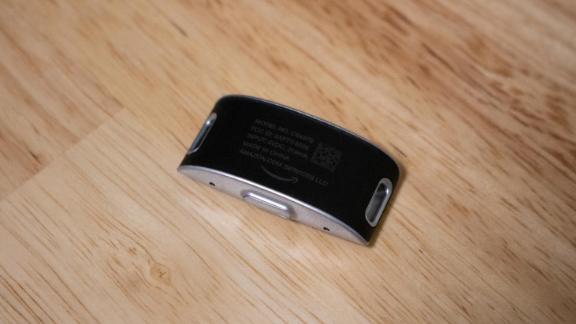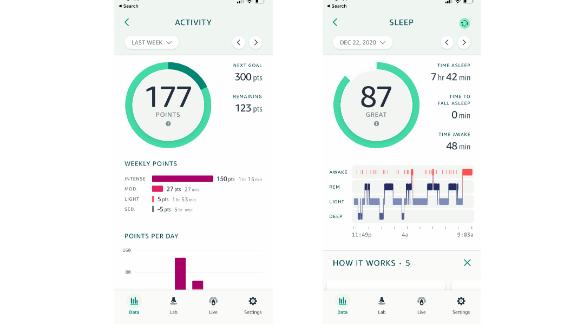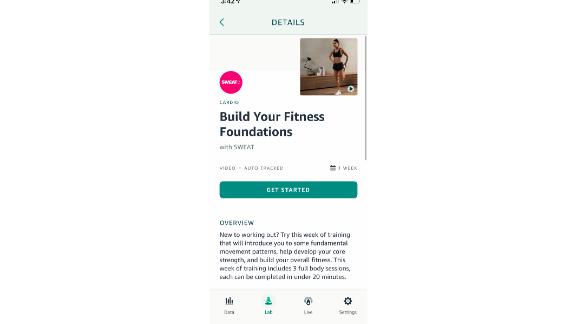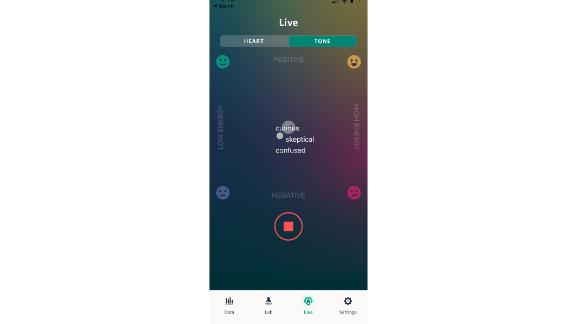(CNN) —
For 2020, we got the expected products from Amazon — and the unexpected. The biggest surprise is Halo, a $99 fitness tracker that can also analyze your tone of voice and measure your body fat, two very personal data points that Apple Watches and Fitbit trackers don’t investigate. It assigns points for levels of movement and sleep, which are the features you;d expect from a fitness tracker. More interestingly, there’s no screen and no vibrations.
Like the first Echo smart speaker and Echo Frames, Halo started off as an invite-only product and later became available for everyone to purchase. We’ve been using both the Day One version, which came out in August, and the one you can buy now, and we couldn’t detect much difference.
Halo costs $99.99 for the physical tracker and a band. That also includes six months of membership at no additional cost. After that, it’s $3.99 a month, and it’s required for using the tracker to its potential.
So after four months and two Halos, let’s break down how this tracker stacks up.
What it is: Amazon’s Halo wristband has two features that set it apart from other fitness trackers — voice tone analysis and body scans. Essentially, it listens to your voice periodically and describes how it sounds. And it lets you calculate body fat percentage with your phone. Those features might creep you out, but know that they can be disabled, and it tracks activity quite well.
What you need to know: Halo doesn’t want to be in the smartwatch space; it’s firmly a fitness tracker that is designed to just work and not interrupt. It has a simple design with no screen and no vibration motor. With an optical heart rate sensor, it can track activity and sleep quite accurately. It presents that info in a very data-centric and easy to digest format. The Labs portion, offering at-home workouts and other wellness aids, is handy, while also justifying the $3.99 a month cost for membership.
How it compares: Amazon’s Halo band is purely focused on fitness and doesn’t go as far to connect you as an Apple Watch or a Fitbit. Both of these feature screens and can let you know when a notification comes through. Halo is a no-frills fitness and activity tracking experience that can really fade into the background. Privacy concerns are valid, though, for body scans and tone analysis.

Amazon’s Halo is a really unassuming device. The tracker itself is a relatively small piece of hardware. There’s no screen for you to view and no vibrating motors inside to buzz your wrist. The only input is a single button, and there are just two microphones. Halo’s bottom side is more interesting, with an optical sensor for heart rate and a set of charging pins. This faces the top of your wrist when being worn.
Along with the Halo, you get a woven fabric bend, made of a strong mesh. It snaps into two divots on the sides of Halo, making a subtle click when you attach the band and a nice popping sound when you remove it. The band comes in three sizes. It’s a simple experience all around, and the Halo is lightweight and pretty comfortable.
You get your pick on color between silver, onyx and gold, and the band is color-matched. Amazon is also selling additional bands, made of mesh or a sport material that feels like rubber. It’s similar to Apple’s approach for the Apple Watch but limited to just two bands right now.
The Halo from its inception is not designed to be constantly pinging you. Unlike Fitbit and Apple Watch, which double as smartwatches, it’s meant to just fade away. That’s why the band fully covers the top of the device, so it’s almost hidden. After about a week of wear, it’s fairly easy to forget that it’s on your wrist.

Also included in the box is a charging clip, similar to how the Fitbit charges and less fancy than an Apple Watch. You’ll open the clip and lay the Halo onto the matching charging pins. As far as battery life, it’s really a tale of two use cases. If you don’t use the tone monitoring, which requires the microphones to be on, battery life hits close to seven days, depending on your activity level. With Tone turned on, we lasted about a day — not that great. You can fully recharge the Halo band in about an hour and 30 minutes.
Lastly, let’s touch on the setup. Halo, like any other fitness tracker or wearable, needs to be paired with an Android or iOS device. You’ll download the Halo app and it will connect to your tracker via Bluetooth. On an iPhone 12 Pro, it took about three minutes to find the Halo and then another few minutes to update the band to the latest software. It doesn’t constantly need to be connected to your phone, though. It will sync a few times to move data points over for Activity, Sleep and Tone.
As a whole, the app is pretty simple, and we like that it’s broken out from the Alexa app.

As any fitness tracker should, Halo will log your movement and sleep. Let’s start with Activity, a core feature of Amazon’s band and of the Halo app. Halo tracks movement via a few sensors (think accelerometers) inside and the optical heart rate sensor. Halo breaks down activity into intense, moderate and light. For instance, a cycling workout may fall in between moderate and intense. It uses your physical movement along with heart rate.
You get points for movement, similar to how Fitbit awards points. The more you move and the harder you work, the more points you receive. But the real kicker is that Halo also removes points when you’re not moving. These times are referred to as sedentary, and you’ll lose one point each time you hit the eight-hour mark of no activity. You are allowed to sleep without penalty, though, and Halo won’t take away points then.
It’s a vastly different tracking system from the Apple Watch and also lacks the vibrant graphics you get when you close rings on an Apple Watch to mark an achievement. Halo’s approach is more data-centric and offers a no-fuss look at your day.
More surprising, though, is that Amazon looks for you to hit 150 points a week as the average, and it came up with this number in collaboration with the American Heart Association. That’s the base goal for all Halo users, but you can of course increase it or decrease it within the app. Similarly, by default, the app will show you your activity on a weekly scale. You can adjust this to a day view or even a month.
And while Halo will show more points being earned during workouts, it’s not smart enough to identify what you were doing during those times. You can log it as whatever activity you select in the app, and it’s a broad range to pick from, so you shouldn’t have any trouble finding the right activity to log.
Halo’s Sleep tracking is just as data- and number-focused. You’ll wear the tracker at night, and it will track your sleep — all types of sleep, from light to REM and deep, as well as those unfortunate moments when you’re awake. In the morning you’re presented with a graph that shows your flow through the different cycles. Halo also gives the total amount of time spent asleep and awake, and how long it took you to fall asleep. This is more data than the Apple Watch provides, and we really like this approach.

And you’ll notice in the app and screenshot above, Amazon offers mini-courses that it calls Labs: tips and approaches to being more active or getting more sleep. They provide a bit more value for the monthly $3.99 cost, and are also pretty neat. The Activity ones offer workout videos, and Mindfulness provides relaxing soundscapes. The most intriguing part is how the app keeps you on track with them. You sign up for them and it will remind you to complete them.
In the end, these features provide ways to be more aware of your health and well-being. The implementation is nice, and we like that it will push you to get that workout on or relaxation time in.

Since we’re immersed in the tech world, we’re generally cool with trying out the more futuristic elements of products. Echo Frames put Alexa around your head. Fitbit Sense monitors stress. We have countless smart speakers and phones listening in every day. But there’s always been concern around microphones or cameras in devices, so it’s no surprise that Amazon is getting some questions and criticism around Halo.
With the two microphones on board, it can listen in and evaluate your tone, describing whether your voice is positive or negative. And with a body scan, you basically let your phone and the Halo app scan your nearly-naked body to get a sense of body fat. It uses the images captured alongside machine learning to tell the difference between your body and the background, and AI for some analysis. It’s borderline creepy, and probably crosses the line for many, but it’s also fully optional. And luckily, Amazon is really up front about this, making it very clear during setup and when you go to explore the Tone or Body sections.
Audio recordings from Tone are all processed on the device and then immediately deleted. For instance, you can’t even play back the recordings the Halo captured. On one hand, that would be a neat feature to try to figure out why you sounded gloomy or joyful. But it’s also the right move when it comes to privacy.
Body Scan images are saved on your device and during processing do get sent off to Amazon’s servers — in a secure manner — then sent back down, leaving the only copy on your device itself. You can avoid having a nearly naked scan sent off by not enabling this feature.
We of course tested both of these and found the Tone feature to be interesting, but not a necessity. On the subject of Body Fat Percentage, it’s a more personal one. From the technology standpoint, it’s impressive that Amazon can complete this with a smartphone, but we don’t have a comparable scan or assessment to test this against. Tone is easier to test, and one that we’ll continue to use. It’s pretty neat, and at the end of the day or a few hours wearing the band, it will note how your overall tone has been. We’re generally pretty happy, but the Halo band judged us as sounding negative and sad. It will even call out specific times during the day, but as we noted above, you can’t hear the audio to make your own decision.
Tone and Body Scans are unique and futuristic features that remind us of a far-out sci-fi flick, maybe even “Black Mirror.” They’re not for everyone, but Amazon also lets you opt out of both and even disable the microphones.
At $99.99, Amazon’s Halo is an unusual fitness and activity tracker. It may put some people off from the get-go, with tone analysis and body scans as two standout features. But remember that they’re off by default, as Amazon is fairly transparent when it comes to privacy on this device.
From a tracking standpoint, Halo is accurate and data-focused for movement or sleep. It matches up with other leading trackers from Apple and Fitbit as well. The Labs section has big potential for helping you stick to goals and reach them, and helps to justify the $3.99 a month plan that rolls out after six months.
Amazon’s Halo succeeds as a good fitness tracker while trying to get cozy and super personal – thankfully you can give it a cold shoulder by turning off tone tracking and body scans.





More Stories
How Medical Practices Benefit from Virtual Assistants
How the Pupil Dilation Velocity and Pupilometer Can Be a Quick and Objective Way to Diagnose TBIs
HEALTH AND FITNESS: Recovering from vacation | Features